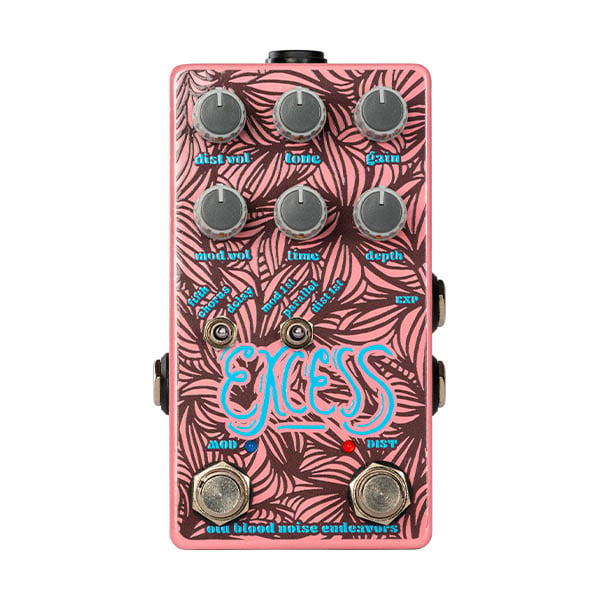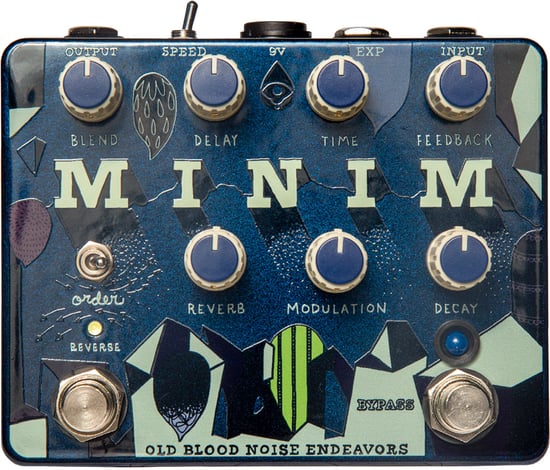Old Blood Noise Excess V2 Distorting Modulator Pedal Overview
Distorting Modulator
A Marriage of Distortion and Delay-Based Effects
Way back in 2017, Old Blood Noise Endeavors released their first venture into Distortion aligned with Delay-based effects. Aptly named Excess, we all thought it was fantastically excessive enough back then, but along comes 2022 and Old Blood Noise are adding more switches. Despite this, the controls are actually dead simple, but the sonic potential is immense!
Expanding on the original model, Old Blood Noise Endeavors continues their journey to revive and expand sought-out sounds of the 80s. With delay, chorus and harmonized fifths available, along with distortion in series or parallel configurations, Excess V2 unveils more unique tones and even more control, yet all in a smaller more pedalboard friendly package.
Main Features:
• Distortion and Modulation pedal
• Three modes of modulation (Delay, Chorus and Fifth) each with Time, Depth, and Volume controls
• Distortion section with control over Gain, Tone and Volume to access light overdrive through fuzzy distortion
• Order switching to run Distortion into Modulation, Modulation into Distortion, or separate parallel paths
• Soft touch switching and true relay bypass for each section
• Expression jack to externally control Rate and Depth
• Internal trimpot to set wet-dry mix of Modulation section
• Made in the USA
• Powered by 9V DC PSU
(centre -, 2.1mm, ~125 mA current draw)
Simply put, Excess V2 is two effects in one: a distortion and a modulation. The modulation takes the form of chorus, delay or pitch shifted delay and the way you route and engage them makes all the difference. Each mode has its own footswitch to engage or disengage the sound. We’re thinking about circuits from the 80s, 90s, today and a little bit earlier, all helping to create tones you’ve never thought of before!
Excess V2 features three modes of modulation. Fifth is a harmonized delay and harmonizes the delay repeat up to a perfect fifth. When depth is turned up (adding delay repeats), those repeats continue to harmonize upward, creating rising fifths and octaves from your original note. Chorus offers a classic chorus, modulating the delay line to create swirling sounds. Delay is a short delay (up to 125ms) focused on comb filter, doubling, and slapback sounds. This section features three knobs, Mod Vol which controls the volume of the modulation, from zero to loud, Rate controls the rate or time of modulation (either the speed of the chorus LFO or the delay time of the delay) and Depth adjusts the depth or feedback of modulation (either the width of the chorus LFO or the number of repeats of the delay).
The Distortion section also has three knobs. While Dist Vol controls the volume of the distortion, from zero to loud, Tone controls the high end of the distortion, from dark to bright. Gain adjusts the gain of the distortion, from bright and almost clean to heavily distorted.
There are three ways of routing the effects in the Excess V2:
• Mod 1st runs modulation into distortion, creating harmonically rich and sometimes almost out of control textures. Because the effects are in series, if either volume control is all the way down, you will get no signal.
• Parallel runs modulation and distortion side by side, which allows for clean modulated signal alongside distorted signal. This mode has a natural volume boost due to the signals being added together. Blend to taste with the volume knobs and find some unfamiliar wet-dry textures.
• Dist 1st runs distortion into modulation, which is a classic way of routing these two effects, allowing for crisp repeats and modulations of your distorted sound. Because the effects are in series, if either volume control is all the way down, you will get no signal.
Internally the Excess V2 has a hidden trimpot located above the expression jack that sets the mix of the modulation section. By default, it is set for a 50-50 mix of dry and wet, allowing for classic chorus and unity volume delay repeats. To increase the mix, turn to the right: this can go 100% wet (affected signal) for true pitch vibrato and strange delay textures. To decrease the mix for more subtle modulation, turn to the left: this can go 100% dry (unaffected) leaving only clean signal on the modulation side.
For even more creativity, the Expression jack can be used to externally control the Rate and Depth knobs. To use it, plug an expression device in using a TRS cable (we recommend the OBNE Expression Slider or Expression Ramper) or any other expression device wired as TRS with tip as the voltage output.
Excess V2 features three modes of modulation. Fifth is a harmonized delay and harmonizes the delay repeat up to a perfect fifth. When depth is turned up (adding delay repeats), those repeats continue to harmonize upward, creating rising fifths and octaves from your original note. Chorus offers a classic chorus, modulating the delay line to create swirling sounds. Delay is a short delay (up to 125ms) focused on comb filter, doubling, and slapback sounds. This section features three knobs, Mod Vol which controls the volume of the modulation, from zero to loud, Rate controls the rate or time of modulation (either the speed of the chorus LFO or the delay time of the delay) and Depth adjusts the depth or feedback of modulation (either the width of the chorus LFO or the number of repeats of the delay).
The Distortion section also has three knobs. While Dist Vol controls the volume of the distortion, from zero to loud, Tone controls the high end of the distortion, from dark to bright. Gain adjusts the gain of the distortion, from bright and almost clean to heavily distorted.
There are three ways of routing the effects in the Excess V2:
• Mod 1st runs modulation into distortion, creating harmonically rich and sometimes almost out of control textures. Because the effects are in series, if either volume control is all the way down, you will get no signal.
• Parallel runs modulation and distortion side by side, which allows for clean modulated signal alongside distorted signal. This mode has a natural volume boost due to the signals being added together. Blend to taste with the volume knobs and find some unfamiliar wet-dry textures.
• Dist 1st runs distortion into modulation, which is a classic way of routing these two effects, allowing for crisp repeats and modulations of your distorted sound. Because the effects are in series, if either volume control is all the way down, you will get no signal.
Internally the Excess V2 has a hidden trimpot located above the expression jack that sets the mix of the modulation section. By default, it is set for a 50-50 mix of dry and wet, allowing for classic chorus and unity volume delay repeats. To increase the mix, turn to the right: this can go 100% wet (affected signal) for true pitch vibrato and strange delay textures. To decrease the mix for more subtle modulation, turn to the left: this can go 100% dry (unaffected) leaving only clean signal on the modulation side.
For even more creativity, the Expression jack can be used to externally control the Rate and Depth knobs. To use it, plug an expression device in using a TRS cable (we recommend the OBNE Expression Slider or Expression Ramper) or any other expression device wired as TRS with tip as the voltage output.




























